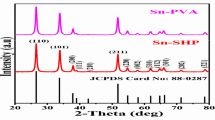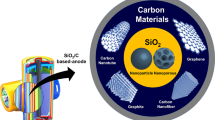Abstract
TiO2-(B)/SnO2 nanostructured composites have been prepared by the combination of an oil-in-water (O/W) microemulsion reaction method (MRM) and a hydrothermal method. Its electrochemical properties were investigated as anode materials in lithium-ion battery, and characterization was carried out by XRD, BET, Raman, FE-SEM, EDXS, and TEM. The as-prepared composites consisted of monoclinic phase TiO2-(B) nanoribbons decorated with cassiterite structure SnO2 nanoparticles. The electrochemical performance of the TiO2-(B)/SnO2 50/50 nanocomposite electrode showed higher reversible capacity of 265 mAh/g than that of the pure SnO2 electrode, 79 mAh/g, after 50 cycles at 0.1 C in a voltage range of 0.01-3.0 V at room temperature. In addition, the coulombic efficiency of the TiO2-(B)/SnO2 50/50 nanocomposite remains at an average greater than 90% from the 2nd to the 50th cycles. The TiO2-(B)/SnO2 50/50 nanocomposite presented the best balance between the mechanical support effect provided by TiO2-(B) that also contributes to the LIB capacity and the SnO2 that provides high specific capacity.










Similar content being viewed by others
References
X. Zhu, S.S. Jan, F. Zan, Y. Wang, and H. Xia: Hierarchically branched TiO2@SnO2 nanofibers as high performance anodes for lithium-ion batteries. Mater. Res. Bull. 96, 405 (2017).
D.-A. Zhang, Q. Wang, Q. Wang, J. Sun, L.-L. Xing, and X.-Y. Xue: Core–shell SnO2@TiO2–B nanowires as the anode of lithium ion battery with high capacity and rate capability. Mater. Lett. 128, 295 (2014).
Z. Yang, G. Du, Q. Meng, Z. Guo, X. Yu, Z. Chen, T. Guo, and R. Zeng: Dispersion of SnO2 nanocrystals on TiO2(B) nanowires as anode material for lithium ion battery applications. RSC Adv. 1, 1834 (2011).
S. Liu, K. Zhu, J. Tian, W. Zhang, S. Bai, and Z. Shan: Submicron-sized mesoporous anatase TiO2 beads with trapped SnO2 for long-term, high-rate lithium storage. J. Alloys Compd. 639, 60 (2015).
J. Hou, R. Wu, P. Zhao, A. Chang, G. Ji, B. Gao, and Q. Zhao: Graphene–TiO2(B) nanowires composite material: Synthesis, characterization and application in lithium-ion batteries. Mater. Lett. 100, 173 (2013).
H.-Y. Wu, M.-H. Hon, C.-Y. Kuan, and I.-C. Leu: Synthesis of TiO2(B)/SnO2 composite materials as an anode for lithium-ion batteries. Ceram. Int. 41, 9527 (2015).
M. Sanchez-Dominguez, L.F. Liotta, G. Di Carlo, G. Pantaleo, A.M. Venezia, C. Solans, and M. Boutonnet: Synthesis of CeO2, ZrO2, Ce0.5 Zr0.5 O2, and TiO2 nanoparticles by a novel oil-in-water microemulsion reaction method and their use as catalyst support for CO oxidation. Catal. Today 158, 35 (2010).
C. Tiseanu, V.I. Parvulescu, M. Boutonnet, B. Cojocaru, P.A. Primus, C.M. Teodorescu, C. Solans, and M.S. Dominguez: Surface versus volume effects in luminescent ceria nanocrystals synthesized by an oil-in-water microemulsion method. Phys. Chem. Chem. Phys. 13, 17135 (2011).
M. Sanchez-Dominguez, H. Koleilat, M. Boutonnet, and C. Solans: Synthesis of Pt nanoparticles in oil-in-water microemulsions: Phase behavior and effect of formulation parameters on nanoparticle characteristics. J. Dispersion Sci. Technol. 32, 1765 (2011).
K. Pemartin, C. Solans, G. Vidal-Lopez, and M. Sanchez-Dominguez: Synthesis of ZnO and ZnO2 nanoparticles by the oil-in-water microemulsion reaction method. Chem. Lett. 41, 1032 (2012).
M.L. Gabriella Di Carlo, A.M. Venezia, M. Boutonnet, and M. Sanchez-Dominguez: Design of cobalt nanoparticles with tailored structural and morphological properties via O/W and W/O microemulsions and their deposition onto silica. Catalysts 5, 442 (2015).
N. Pineda-Aguilar, L.L. Garza-Tovar, E.M. Sánchez-Cervantes, and M. Sánchez-Domínguez: Preparation of TiO2–(B) by microemulsion mediated hydrothermal method: Effect of the precursor and its electrochemical performance. J. Mater. Sci.: Mater. Electron. 29 (2018).
M. Sanchez-Dominguez, M. Boutonnet, and C. Solans: A novel approach to metal and metal oxide nanoparticle synthesis: The oil-in-water microemulsion reaction method. J. Nanopart. Res. 11, 1823 (2009).
M. Sanchez-Dominguez, K. Pemartin, and M. Boutonnet: Preparation of inorganic nanoparticles in oil-in-water microemulsions: A soft and versatile approach. Curr. Opin. Colloid Interface Sci. 17, 297 (2012).
M. Boutonnet, J. Kizling, P. Stenius, and G. Maire: The preparation of monodisperse colloidal metal particles from microemulsions. Colloids Surf. 5, 209 (1982).
I. Lisiecki, F. Billoudet, and M.P. Pileni: Control of the shape and the size of copper metallic particles. J. Phys. Chem. 100, 4160 (1996).
G.H. Du, Q. Chen, R.C. Che, Z.Y. Yuan, and L.-M. Peng: Preparation and structure analysis of titanium oxide nanotubes. Appl. Phys. Lett. 79, 3702 (2001).
T. Beuvier, M. Richard-Plouet, and L. Brohan: Accurate methods for quantifying the relative ratio of anatase and TiO2(B) nanoparticles. J. Phys. Chem. C 113, 13703 (2009).
A. Diéguez, A. Romano-Rodríguez, A. Vilà, and J.R. Morante: The complete Raman spectrum of nanometric SnO2 particles. J. Appl. Phys. 90, 1550 (2001).
L. Li: Growth and photoluminescence properties of SnO2 nanobelts. Mater. Lett. 98, 146 (2013).
C.S. Ferreira, P.L. Santos, J.A. Bonacin, R.R. Passos, and L.A. Pocrifka: Rice husk reuse in the preparation of SnO2/SiO2 nanocomposite. Mater. Res. 18, 639 (2015).
M. Thommes, K. Kaneko, V. Neimark Alexander, P. Olivier James, F. Rodriguez-Reinoso, J. Rouquerol, and S.W. Sing Kenneth: Physisorption of gases, with special reference to the evaluation of surface area and pore size distribution (IUPAC technical report). Pure Appl. Chem., 1051 (2015).
Y. Zhou, C. Jo, J. Lee, C.W. Lee, G. Qao, and S. Yoon: Development of novel mesoporous C–TiO2–SnO2 nanocomposites and their application to anode materials in lithium ion secondary batteries. Microporous Mesoporous Mater. 151, 172 (2012).
M. Zukalová, M. Kalbáč, L. Kavan, I. Exnar, and M. Graetzel: Pseudocapacitive lithium storage in TiO2(B). Chem. Mater. 17, 1248 (2005).
Q. Wang, Z. Wen, and J. Li: Solvent-controlled synthesis and electrochemical lithium storage of one-dimensional TiO2 nanostructures. Inorg. Chem. 45, 6944 (2006).
N. Li, C.R. Martin, and B. Scrosati: A high-rate, high-capacity, nanostructured tin oxide electrode. Electrochem. Solid-State Lett. 3, 316 (2000).
F. Wang, G. Yao, M. Xu, M. Zhao, Z. Sun, and X. Song: Large-scale synthesis of macroporous SnO2 with/without carbon and their application as anode materials for lithium-ion batteries. J. Alloys Compd. 509, 5969 (2011).
T.-F. Yi, J. Shu, Y.-R. Zhu, X.-D. Zhu, R.-S. Zhu, and A.-N. Zhou: Advanced electrochemical performance of Li4Ti4.95V0.05O12 as a reversible anode material down to 0V. J. Power Sources 195, 285 (2010).
Z. Sun, J.H. Kim, Y. Zhao, F. Bijarbooneh, V. Malgras, Y. Lee, Y.-M. Kang, and S.X. Dou: Rational design of 3D dendritic TiO2 nanostructures with favorable architectures. J. Am. Chem. Soc. 133, 19314 (2011).
H. Jiang, X. Yang, C. Chen, Y. Zhu, and C. Li: Facile and controllable fabrication of three-dimensionally quasi-ordered macroporous TiO2 for high performance lithium-ion battery applications. New J. Chem. 37, 1578 (2013).
I.A. Courtney and J.R. Dahn: Key factors controlling the reversibility of the reaction of lithium with SnO2 and Sn2 BPO6 glass. J. Electrochem. Soc. 144, 2943 (1997).
A.R. Armstrong, G. Armstrong, J. Canales, R. García, and P.G. Bruce: Lithium-ion intercalation into TiO2-B nanowires. Adv. Mater. 17, 862 (2005).
M. Winter and J.O. Besenhard: Electrochemical lithiation of tin and tin-based intermetallics and composites. Electrochim. Acta 45, 31 (1999).
V. Palomares, A. Goñi, I.G.d. Muro, I. de Meatza, M. Bengoechea, I. Cantero, and T. Rojo: Conductive additive content balance in Li-ion battery cathodes: Commercial carbon blacks vs. in situ carbon from LiFePO4/C composites. J. Power Sources 195, 7661 (2010).
C.-Z. Lu and G.T.-K. Fey: Nanocrystalline and long cycling LiMn2O4 cathode material derived by a solution combustion method for lithium ion batteries. J. Phys. Chem. Solids 67, 756 (2006).
T. Kasuga, M. Hiramatsu, A. Hoson, T. Sekino, and K. Niihara: Formation of titanium oxide nanotube. Langmuir 14, 3160 (1998).
Acknowledgments
The authors express their gratefulness to the Project SEP-CONACYT CB-2012-01 #189865 and Project SEP-CONACYT CB-2011 #166649. This work was also supported by PAICYT-UANL program through project number IT468-15. The authors also acknowledge Dr. Alonso Concha Balderrama (CIMAV Monterrey), M.C. J. Alejandro Arizpe Zapata (CIMAV Monterrey), QFB Julio Rivera Haro (CIMAV Monterrey), and Departamento de Ecomateriales y Energía (FIC-UANL) for their help with XRD, Raman, ICP-OES, and BET measurements, respectively. Also, the support of Dra. Raquel Garza with the AAnalyzer® software (deconvolution of Raman peaks) is recognized. We thank Dr. Isaías Ramírez Juárez (FIC-UANL) and QFB Silvia López (FIC-UANL) for their support in the SEM characterization of the cycled electrodes.
Author information
Authors and Affiliations
Corresponding authors
Supplementary materials
Supplementary materials
To view supplementary material for this article, please visit https://doi.org/10.1557/jmr.2020.213.
Rights and permissions
About this article
Cite this article
Pineda-Aguilar, N., Sánchez-Domínguez, M., Sánchez-Cervantes, E.M. et al. Preparation of TiO2-(B)/SnO2 nanostructured composites and its performance as anodes for lithium-ion batteries. Journal of Materials Research 35, 2491–2505 (2020). https://doi.org/10.1557/jmr.2020.213
Received:
Accepted:
Published:
Issue Date:
DOI: https://doi.org/10.1557/jmr.2020.213




